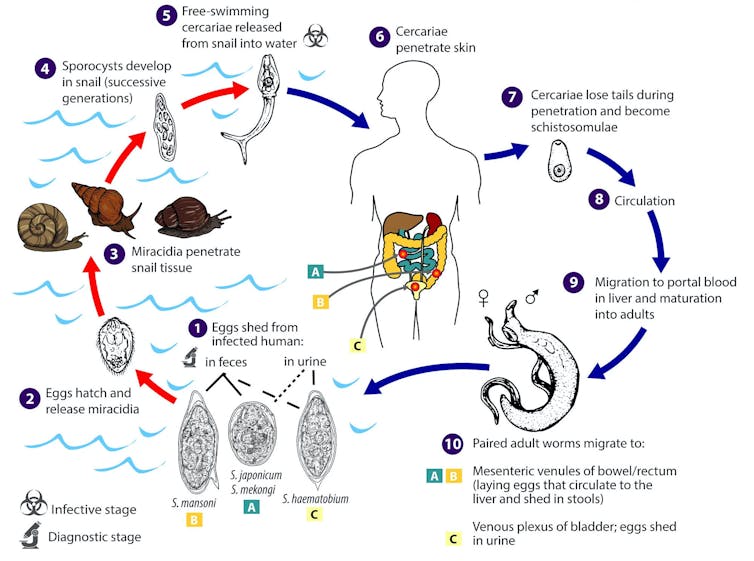Blood samples of patients infected with a parasitic worm that causes schistosomiasis contain hidden information that marks different stages of the disease. In our recently published research, our team used machine learning to uncover that hidden information and improve early detection and diagnosis of infection.
The parasite that causes schistosomiasis completes its life cycle in two hosts – first in snails and then in mammals such as people, dogs and mice. Freshwater worm eggs enter human hosts through the skin and circulate throughout the body, damaging multiple organs, including the liver, intestine, bladder and urethra. When these larvae reach blood vessels connecting the intestines to the liver, they mature into adult worms. They then release eggs that are excreted when the infected person defecates, continuing the transmission cycle.
Since diagnosis currently relies on detecting eggs in feces, doctors usually miss the early stages of infection. By the time eggs are detected, patients have already reached an advanced stage of the disease. Because diagnosis rates are poor, public health officials typically mass-administer the drug praziquantel to populations in affected regions. However, praziquantel cannot clear juvenile worms in early stages of infection, nor can it prevent reinfection.

Schistosomiasis isn’t usually diagnosed until the late stages of the disease.
DPDx/CDC
Our study provides a clear path forward to improving early detection and diagnosis by identifying the hidden information in blood that signals active, early stage infection.
Your body responds to a schistosomiasis infection by mounting an immune response involving several types of immune cells, as well as antibodies specifically targeting molecules secreted by or present on the worm and eggs. Our study introduces two ways to screen for certain characteristics of antibodies that signal early infection.
The first is an assay that captures a quantitative and qualitative profile of immune response, including various classes of antibodies and characteristics that dictate how they communicate with other immune cells. This allowed us to identify specific facets of the immune response that distinguish uninfected patients from patients with early and late-stage disease.
Second, we developed a new machine learning approach that analyzes antibodies to identify latent characteristics of the immune response linked to disease stage and severity. We trained the model on immune profile data from infected and uninfected patients and tested the model on data that wasn’t used for training and data from a different geographical location. We identified not only biomarkers for the disease but also the potential mechanism that underlies infection.
Why it matters
Schistosomiasis is a neglected tropical disease that affects over 200 million people worldwide, causing 280,000 deaths annually. Early diagnosis can improve treatment…


